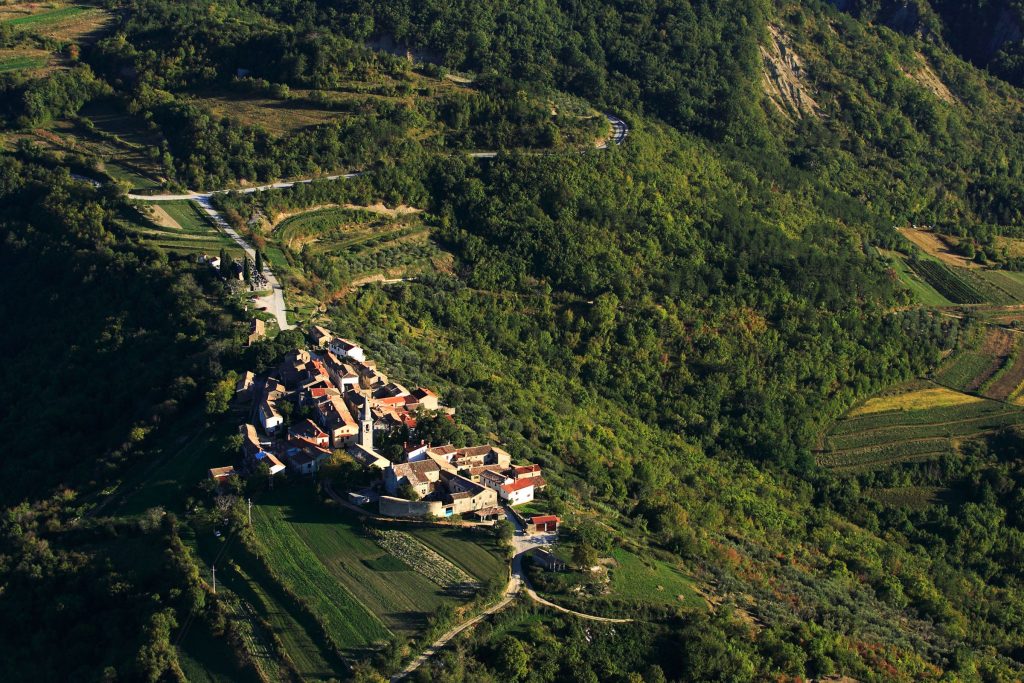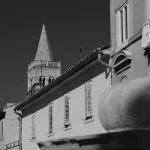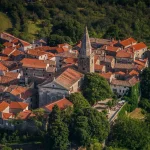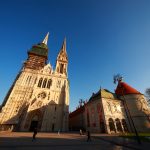We’ve explored many of the dialects, subdialects and indeed languages in their own right as some linguists consider them to be which are spoken across modern Croatia. From the Dubrovnik subdialect (Ragusan) in the extreme south of Dalmatia to Northwestern Kajkavian in areas like Zagorje, the ways in which people speak in this country deviate from what we know as standard Croatian language enormously. That goes without even mentioning much about old Dalmatian, Zaratin, once widely spoken in and around Zadar, Istriot, or Istro-Venetian.
What about minority languages in Croatia, though? While some of the above might seem as if they themselves are minority languages, with so much controversy about whether they’re languages or mere dialects has unfortunately caused many to not even be given a proper protected status. It’s true that some are even on UNESCO endangered languages list, but they’re still not categorised by the Croatian powers that be in the same way that the likes of Czech, Hungarian or Slovakian are in this country.
Let’s look into what exactly is deemed to be a minority language in Croatia and how that functions within the Croatian Constitution.
Minority languages in Croatia are the mother tongues (first languages) of national and ethnic minorities living across modern Croatian territory. In addition to personal and intra-community use, minority languages in Croatia are used in different ways and to varying extents in both official and public areas.
The Croatian Constitution defines the Republic of Croatia as the nation of the Croatian people, the country which belongs to all its citizens, including traditional autochthonous communities, which the constitution refers to as national minorities. The minorities explicitly listed in the constitution are; Serbs, Czechs, Italians, Hungarians, Slovaks, Jews, Germans, Ukrainians, Ruthenians, Austrians, Bosniaks, Slovenes, Macedonians, Russians, Montenegrins, Bulgarians, Poles, Romanians, Turks, Roma, Vlachs and Albanians.
Article 12 of the Croatian Constitution states that the official language in Croatia is what we now call standard Croatian, while for some local self-government units (cities and municipalities) another script may be introduced into official comparative use.
Now we’ve seen who the national minorities are, how do minority languages in Croatia stand under the law?
The use minority languages in Croatia is regulated on the basis of competent national laws, international conventions and agreements which the country has signed. The most important laws at the national level are the Constitutional Law on the Rights of National Minorities, the Law on the Use of the Language and Script of National Minorities and the Law on Education in the Language and Script of National Minorities. The most important international agreements related to minority languages in Croatia are the European Charter on Regional or Minority Languages and the Framework Convention on the Protection of National Minorities adopted by the Council of Europe. The members of national minorities have acquired certain rights in this country over time through interstate and international treaties and agreements, such as the Erdut Agreement and the Rapala Treaty.
It’s unfortunate to say but must be said regardless, that the Croatian public and in many cases the authorities don’t always have much of a positive attitude towards issues experienced by minorities in this country, and as such minority rights, but Croatia’s EU membership has had an overall very positive impact on the affirmation of the official use of minority languages in Croatia, and things in that respect continue to stabilise as time goes by.
There are several Croatian municipalities in which what are deemed to be official minority languages are spoken today.
German
The National Association of Danube Swabians, which is the largest minority association of the German Community, strongly advocates for German language use in the Eastern part of the country, particularly in and around Osijek where it holds a form of traditional status. In modern Croatia, spoken German is primarily the first or second foreign language someone has, and it is also recognised as the official minority language of both Germans and Austrians living in Croatia.
Czech
Over 6000 people living in the continental Croatian county of Bjelovar-Bilogora have declared themselves to be members of the Czech national minority. 70% of these individuals say that Czech is their mother tongue. Back in 2011, MP Zdenka Cuhnil pointed out that based on their acquired rights, the Czech minority in Croatia has the right to equal use of the language (alongside standard Croatian) in nine local self-government units.
Ruthenian
The Ruthenian dialect spoken in both Vojvodina and modern Croatia became standardised back during the first half of the 20th century, with Ruthenian publications having been being published since the 1920s. While in Ukraine, the Ruthenian community isn’t officially recognised as being a separate nation, minority status and language rights outside of Vojvodina and Croatia were recognised and began to develop only in the post-Cold War period.
The Ruthenians living in the area of Eastern Slavonia don’t differ from the Ruthenians living in Vojvodina culturally or linguistically. It is worth noting however that Ruthenian spoken in this area does differ from the speech of other Ruthenian communities located elsewhere, and is characterised by a significant number of loanwords from Croatian as we know it today. The use of the Ruthenian language on the whole began to decline after the Second World War, and the process accelerated even more following the end of the Homeland War (Croatian War of Independence).
Romany (Roma language)
While the Croatian Parliament formally recofnised the Day of the Roma Language (May the 25th) back in 2012, the Central Library of Roma in Croatia, which is also the only Roma library in all of Europe, was on;y opened back during the summer of 2020, so not long ago at all when you consider the length of time the Roma people have been present in this country and the wider region. The Roma people are among those who experience a lack of help when it comes to the authorities, and issues between this community and the general public are rife for a multitude of reasons.
Slovakian
A magazine called Pramen is published in the Slovakian language by the Union of Slovaks in Croatia. This was achieved thanks to cooperation with the Slovak Cultural Centre (located in Nasice). Back in 2011, over 500 students in the Eastern part of the country were taught Slovakian twice per week from the first grade of elementary school onwards.
Ukrainian
The Ukrainian community present in Croatia publishes the following publications in the Ukrainian language – Nova Dumka, Vjesnik, Nasa Gazeta, Vjencic (aimed at kids) and Misli s Dunava. Since way back in 2001, the Department of Ukrainian Language and Literature has been in function at the Faculty of Philosophy of the University of Zagreb. Following the outbreak of war in Ukraine following shock Russian invasion back in February 2022, Ukrainian presence has been far stronger in Croatia thanks to its very welcoming stance towards Ukrainian refugees fleeing Russian onslaught in their homeland. As a result, it’s likely that the language will be heard much more.
Hebrew and Yiddish
The library of the Jewish Municipality of Zagreb actually doesn’t (yet, anyway) have the status of one of the central minority libraries of Croatia. In addition to the library in Zagreb, the Hugo Kon Elementary School, founded in 2003, is also in operation. The Festival of Tolerance – The Jewish Film Festival was founded back in 2007 by the well known Branko Lustig with the aim of preserving the memory of those lost during the Holocaust and promoting tolerance going forward so that such horrors are never repeated.
Hungarian
When it comes to higher education institutions in Croatia, Hungarian can be studied at the University of Zagreb, the Josip Juraj Strossmayer University in Osijek, and most recently at the University of Rijeka. To turn the wheels of time back a little, it’s worth remembering that much of Croatian territory was once under the reign of the former Austro-Hungarian empire, and aside from being our neighbours, Hungary and as such Hungarian language has had quite the influence on this country over the centuries. Now classed as one of the official minority languages in Croatia, Hungarian has been advocated for in many ways here. Back in 2004, representatives of the Hungarian national minority called for the introduction of Hungarian into official use in Beli Manastir, referring to the rights acquired by Hungarian nationals before 1991 and the complications which arose due to the outbreak of war. In the same year (2004) the Hungarian minority made up 8.5% of Beli Manastir’s resident population.
Italian
I’ve written numerous articles on the array of dialects and subdialecs spoken across the Istrian peninsula, most of them deriving in some way from Venetian. These dialects (and some linguists would argue them to be languages in their own right) come from the complex and very long history Italy and Istria share, as the two are deeply historically, culturally and as such linguistically enmeshed. As such the Italian minority in Croatia achieved a significantly wider right to use their own language than all other minority communities in the country. La Voce del Popolo is a daily newspaper published in the Italian language that is published in Rijeka. On top of that, we also have the likes of Istro-Venetian, which is sparsely spoken in comparison to standard (modern) Italian, and you can learn more about it here.
Serbian
By far the most controversial of all, and for obvious reasons, is the Serbian language as one of the Croatian minority languages. I probably don’t need to go into the ins and outs of why it is controversial in comparison to the others, as that would be an article of its own. Instead, I’ll just list some facts.
Education in Serbian was made possible in the territory of the former self-proclaimed Eastern Slavonia, Baranja and western Srijem on the basis of the aforementioned Erdut Agreement, which created the preconditions for the peaceful reintegration of the Croatian Danube region. In this region, teaching is conducted according to Model A of minority education, in which the entire teaching takes place in the language and script of national minorities – in this case it is Serbian. Schools in Podunavlje, for example, do organise classes in Croatian or in another minority language if the minimum number of students to enroll in a class according to a certain model are present.
Critics see the continuation of the Croatian-Serbian conflict in the Danube region in the model of divided classes, while the official representatives of the Serbian minority see the negative attitude towards the Serbian departments as pressure in the direction of denationalisation. In either case, the use of the Cyrillic script on road signs, on buildings and indeed elsewhere in parts of Croatia which were ravaged by Serbian onslaught back during the nineties are far from popular and have remained a burning issue ever since the Homeland War drew to a close.
Of the other languages, one which is sadly dying out at an alarming rate is the Istro-Romanian language, which is listed in UNESCO’s own Red Book of Endangered Languages as seriously endangered. With Istro-Romanian likely to follow the same path as Istrian-Albanian and become extinct within the next few decades, if not sooner, little is being done to preserve it for generations to come.
For more on Croatian languages, history, minority languages and dialects, follow our lifestyle section.












